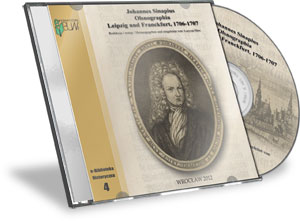Olsnographia oder Eigentliche Beschreibung des Oelßnischen Fürstenthums in Nieder-Schlesien
[electronic document]. Vol.1-2 / ed. and introduction Lucyna Harc
|
Author: Sinapius, Johann (1667-1725) Edition I Format of publication: PDF |
|
Accessible in Digital Library of Wroclaw University
https://www.bibliotekacyfrowa.pl/dlibra/publication/37046
Summary
This edition is an electronic version of a two-volume description of Oleśnica (Oels) and the Duchy of Oleśnica written and published by Johannes Sinapius at the beginning of the 18th century, here called in short Olsnographia. The general characterization of Olsnographia, is preceded by a introduction presenting the author’s life, his works as compared to modern historical writing in Silesia, the motivation behind his laborious and thorough research, sources he used, the main idea and structure of his work, and a short description of its cont.
Johannes Sinapius (other forms of his family name: Senf, Senfft, Sinapius- Horčička) represented an old Silesian family known already in the 16th century. His grandfather moved to the Spisz (Scepusium) area, Northern Hungary at the time (the territory of Slovakia today). Daniel Sinapius, the author’s father, left Hungary for Silesia in 1673 to escape the persecution of Protestants and finally, as a refugee, settled down in the Polish Commonwealth. Johannes Sinapius was Daniel’s first son, born 1 September 1667 in a small town called Teplá (Bad Liptsch) situated in the Liptov province, former Hungarian territory. Johannes spent most of his life in Silesia. He graduated from secondary school in Brzeg (Brieg) and after completing studies in Halle and Leipzig, in June, 28th, 1692, he was appointed prorector and librarian in Gymnasium Illustre, school founded by Duke Karl II of Poděbrady. Two years later, when he was 27, Johannes Sinapius married Maria Elizabeth Titz from Oleśnica with whom he spent the rest of his life and had six children. Their son Johannes became a lawyer while another son Daniel became a doctor. In 1700 Sinapius reached the position of rector of Gymnasium Illustre while still holding the position of school librarian. At the same time, for a year and a half, he was teaching the sons of Duke Christian Ulrich I: Karl Friedrich and Christian Ulrich II. Eight years later, in May, 14th, 1708, he accepted the position of rector of Schola Ducalis Senatoria (Vereinigte Fürstliche und Stadtschule, an evangelical school of even better reputation than the excellent Gymnasium Illustre in Oleśnica. Sinapius was holding the position for 17 years till the day of his sudden death on 5 October 1725. He was 58 years old.
Johannes Sinapius’ literary activity, as a chronicler in particular, was valued by readers of his time and by the next generations. He inherited writing skills from his gifted father, paternal uncle and grandfather. He was interested in history and genealogy. Soon after he came to the town, Sinapius began extensive research on the history of the Duchy of Oleśnica. The basis and the starting point of his own profound research were the references to certain events from the past of the duchy he found in some earlier Works. His efforts resulted in a thorough, two-volume publication entitled Olsnographia, Oder Eigentliche Beschreibung Des Oelßnischen Fürstenthums In Nieder-Schlesien (…) i.e. Olsnographia or the Real History of the Duchy of Oleśnica in the Lower Silesia (…). Published in Leipzig and Frankfurt, Olsnographia was the chronicle of the town and the Duchy of Oleśnica.
In the next years, Sinapius research concentrated on the history of Silesian nobles. Thus, he continued studies on this issue already mentioned inOlsnographia where he listed the noble families of the Duchy of Oleśnica. It is a matter of fact that Sinapius was the first one who did genealogical research of the area. The first volume of his genealogy entitled Schlesischer Curiositäten erste Vorstellung, darinnen die ansehnlichen Geschlechter des schlesischen Adels… (Interesting Facts about Silesia Part One, Including a Description of Noble Silesian Families) was published in 1720. The second volume, entitled Des Schlesischen Adels anderer Theil oder Fortsetzung Schlesischer Curiositäten ((Interesting Facts about Silesia – Silesian Nobility, A Continuation) appeared in 1728 in Leipzig, already after Sinapius’ death. Johannes Sinapius is also supposed to have been the author of the manuscript Deducto genealogia familiae Sinapianae (Genealogy of the Sinapius Family) kept in the National Széchényi Library in Budapest.
Beside the two famous works mentioned above, Sinapius was also the author of less known school programs, written in the style of that time. He wrote some plays for the students of Gymnasium Illustre and later for students in Legnica (Liegnitz), where he became rector in 1708. He also wrote occasional booklets. One example of these particularly worth mentioning is a list of all Dukes of Oleśnica composed in distich and published in 1702.
Sinapius’ description of the Duchy of Oleśnica and its capital follows the models of the rich Silesian historiography of the time. The title of Olsnographia is a clear reference to Silesiographia and Breslographia. written by Nicolaus Henel in the Renaissance period. At the same time, however, the elaborate, descriptive title brings to mind the suggests a baroque, antiquarian work Schlesiens curiose Denkwürdigkeiten by a distinguished Silesian author Friedrich Lucae. Sinapius’ approach as well as his aspiration to collect as much information as possible resulted in 1664 pages of text, not counting supplements and indices. Because of this impressive number of pages, Olsnographia had to be published in two volumes.
Johannes Sinapius dedicated his description of Oleśnica and the Duchy of Oleśnica to the young dukes Karl Friedrich and Christian Ulrich II, the sons of Christian Ulrich I who died in 1704. In his foreword to the first volume of Olsnographia Sinapius expresses his hope that the readers will enjoy reading his work as much as he enjoyed writing it. He also states the reasons why he wrote. He explains that he decided to study the history of the town and the duchy because it was his duty to express his love for the region of Silesia and his ancestors who had been living there. Therefore he decided to study the history of the town and the duchy. The rich and still growing resources of the school library, which Sinapius was responsible for, were very helpful in his research. Another reason that he continued his research was that he found that among geographical and historical works about Silesian towns and duchies there were no dissertations on the Duchy of Oleśnica.
Johannes Sinapius divided the completed text into two parts that were then published as separate volumes. While the first volume appeared in 1707, the second, according to the information on the title page, was published in 1706. It is very possible, however, that the date is a mistake.
The structure of Olsnographia resembles the structure of geographical and historical descriptions popular in the 16th and the 17th centuries. In such works, information was arranged in chronological order and grouped it into thematic chapters that were in turn divided into sub-chapters focusing on specific, individual issues. Sinapius used this model in his description of the Duchy of Oleśnica and its capital.
The first volume, containing general information about the Duchy of Oleśnica, is divided into four major parts called treatises. Each treatise has several chapters. The titles of the first three treatises are descriptive:
-
First Treatise. The Duchy of Oleśnica (Erste Abhandlung. Von des Oelßnischen Fürstenthums) – pp 1-58
-
Second Treatise. The Dukes of Oleśnica (Andre Abhandlung. Von des Oelßnischen Fürstenthums Regenten) – pp 59-336
-
Third Treatise. Religion in the Duchy of Oleśnica (Die Dritte Abhandlung. Von dem Religions-Zustande des Oelßnischen Fürstenthums) – pp 337-504
-
Fourth Treatise (Vierdte Abhandlung) – pp 505-992
The second volume is divided into three parts. Each of them is a description of one town and its respective municipal area (weichbild). Like in the first volume, each part is divided into sub-chapters concerning separate subjects and all information is put in chronological order. Titles of the chapters, however, are no longer descriptive. Instead, editor decided to briefly summarize their conten. The three treatises are followed by supplements to both volumes with separate pagination (starting with page one) and an alphabetical index without pagination. The content of the second volume is as follows:
-
First Treatise (Erste Abhandlung) – pp 3-452 – concerns the town of Oleśnica and Oleśnica municipal area
-
Second Treatise (Andre Abhandlung) – pp 453-586 – concerns Bierutów (Bernstadt) as duke’s residence and Bierutów municipal area.
-
Third Treatise (Dritte Abhandlung) – pp 587-672 – concerns Dobroszyce (Treskin) as duke’s residence and Trzebnica (Trebnitz) municipal area.
-
New Comments to Volume One (Neue Anmerckungen. Zum Ersted Theile) – pp 1 (673)-35 (707).
-
Comments to Volume Two (Anmerckungen zum Andern Theile) – pp 35 (707)-48 (720).
-
Index to Olsnographia (Register über die Olsnographie, Dabay zu mercken, daß die erste und große Zahl den Theil derselben, die andere und kleinere das Blat bezeichnet) – no pagination (pp 721-797) – names, place names, subjects.
-
Errata to Volumes One and Two (Weil ich in meiner Olsnographie noch etliche Sachen gefunden, die sonderl. in Jahrzahlen einer Erinn- und Vebesserung bedörffen, als habe ich solche auch allhier am Ende noch hinzu setzen wollen) – no pagination (pp 797-801).
Considering its content and a large number of collected facts, the two-volume Olsnographia by Johannes Sinapius is a rich source of detailed information about the town of Oleśnica, the Duchy of Oleśnica, and the inhabitants of the area living here from the early ages up till the beginning of the 18th century. Certainly, all information provided by Olsnographia should be verified, reviewed and critically analyzed. The current edition of Olsnographia as an e-book will make this excellent work of early modern Silesian historiography accessible to a wider range of researchers.

